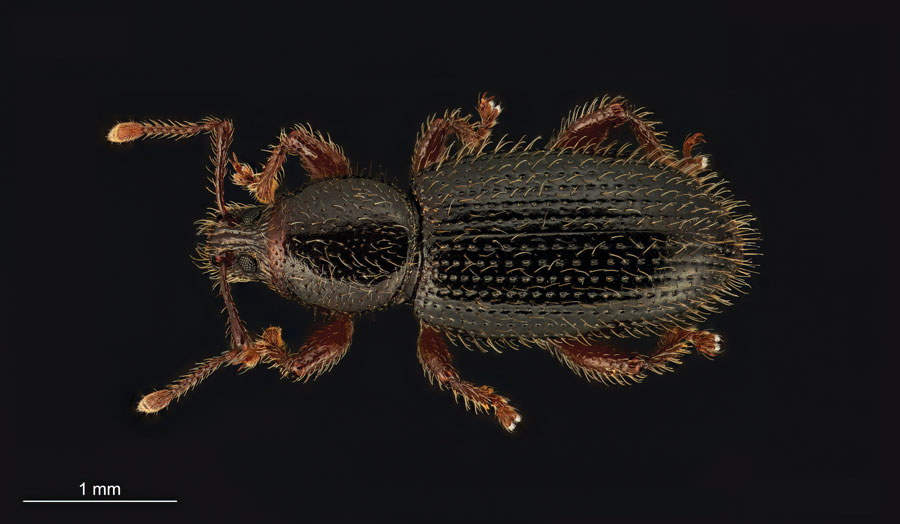Key points
- Molecular analysis has confirmed the Dongara weevil is a new species. Accurate identification will provide clear communication about the weevil and better management strategies
- The weevil causes significant damage and economic loss to canola crops and it hides, making it elusive and challenging to manage
- Ongoing research aims to better understand its life cycle, activity periods, dormancy and insecticide tolerance together with other characteristics that will help inform its management
After causing crop losses for over a decade across localised areas of the northern Western Australian wheat belt, the tiny culprit has finally been scientifically named – Otiorhymirus dongara, commonly known as the ‘Dongara weevil’.
Scientific naming of organisms serves as the official language for precise and unambiguous identification. Correctly identifying the Donaga weevil now allows clear communication for improving management, lessening confusion and minimising duplication in research, development and extension.

Otiorhymirus dongara, the Dongara weevil. Photo:Pia Scanlon, DPIRD
GRDC supported the sleuthing task in pursuit of the Dongara weevil in 2022, shortly after the grower-led National Grower Network scheme commenced in 2021. This two-year investment has seen the Department of Primary Industries and Regional Development (DPIRD) work in collaboration with Murdoch University and Mingenew Irwin Group.
About the Dongara weevil
DPIRD’s Dr Dustin Severtson is leading the work and says that although weevils are a major crop pest, they are usually localised as they are not as mobile as other insects.
“The Dongara weevil has often been overlooked and misidentified,” he says.
The Dongara weevil has been scientifically described based on specimens collected between 2013 and 2023 and named by DPIRD entomologist Andras Szito. Molecular analysis by Dr Ben Congdon (DPIRD) and Murdoch University has shown that Dongara weevil sequences formed an isolated clade (insect group), indicating it to be a new species.
The Dongara weevil can now be distinguished from other common weevil pests based on colour, size and shape of the body parts.
“Dongara weevils have a shiny dark brown to black appearance without prominent markings, a short, blunt snout and prominent, bent antennae,” Dr Severtson says. “They are approximately three to five millimetres long and flightless. Only adults have been found to date and their life cycle remains unknown.”
By comparison, the vegetable weevil (Listroderes obliquus)is 10 to 12mm long with white markings along the side of the body. Fuller’s rose weevil (Pantomorus cervinus) is 8 to 10mm with yellow stripes on the side and back of the body. Small lucerne weevil (Atrichonotus taeniatulus) is 5mm long and light grey with a white stripe on each side of the body. Desiantha or spotted vegetable weevil (Steriphus diversipes) is 5mm long and dark coloured with grey flecks on its back and a typical, long down-curving weevil snout.
“Our surveillance work is showing the Dongara weevil appears to be a pest during crop emergence, causing more harm to canola and in areas with heavier soils than in areas of light soil. Additionally, it is proving challenging to control with insecticide rates typically effective against other weevil species.”
Jacqui Meares from Mingenew Irwin Group has been leading the trapping surveillance work in the Mingenew region and says the Dongara weevil is quite elusive.
“It is tiny and very adept at hiding under leaves, in cracks or under soil clods to avoid insecticides.
And when conditions are conducive, and in particular in canola crops when a weevil infestation takes off, the damage can be alarming.
Ms Meares says in surveys in 2023, Dongara weevils were detected at eight out of 20 sites in the Dongara and Mingenew regions.
She says they either may eat plants before they emerge, chew through emerging stems of canola cotyledons, or damage emerging plants to the extent that they are quite stunted. “They are very efficient feeders and tend to hide at the base of plants.”
She says they can be present in wheat and barley crops but do not appear to cause any damage.
“Regardless of crop type, they seem, based on our trapping results, to be active throughout the season.”
Need to know more
Dr Severtson says that now the weevil has been formally identified and can be differentiated from other weevil species, it is important to learn more about the pest to inform its management.
“We need to learn about the Dongara weevil’s life cycle, when it is most active, how it over-summers, any dormancy phases, resistance to insecticides and other aspects. This information is essential to pinpoint its weaknesses and develop effective management strategies.”
Further monitoring will be conducted this season, and remote imaging pitfall trap devices have been developed as part of GRDC’s National Grains Diagnostics and Surveillance Initiative (NGDSI), which is a national co-investment with state government departments.
In the meantime, avoiding planting canola in paddocks suspected to harbour the Dongara weevil and managing summer and fenceline weeds, particularly cape weed, which the weevil favours, may help reduce economic loss.
“Burning crop residues prior to sowing canola will also decrease the amount of trash where weevils can hide when spraying.”
More information: Dustin Severtson, dustin.severtson@dpird.wa.gov.au

























































